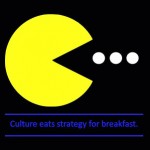This article and its corresponding photo are republished with permission from www.howtoflyahorse.com. For more from author Kevin Ashton, attend our Senior Executive Roundtable on November 20th. The secret of Steve is simple. It explains his success and excess. It exemplifies our instinct for creation. Creating is not a result of genius, unconscious incubation or aha! moments.

In his book, Good to Great, Jim Collins writes that great companies have a firm understanding of three key things – what they are deeply passionate about (including core values and purpose); what drives their economic engine; and what they can be the best at in the world. To set and execute strategy, they translate these understandings into a simple, crystalline
Executives can no longer ignore the fact that business is a social institution and cannot exist outside the contextual environments in which it operates. Firm stakeholders continue to pressure business to make a more positive impact on social issues ranging from employee well being, to environmental sustainability, to community enhancement. These goals can only be
The most effective leaders who consistently achieve and surpass organization, team, and individual performance goals and objectives do not achieve their success by chance or good fortune. As a retired Coast Guard Captain, aviator, and operational planner, my own experience reveals that successful leadership requires compelling attention to the daily practice of five key power

Editor’s Note: Every quarter we assemble a small group of CEOs and top executives, and ask them the same questions. The answers offer insights into the strategies and processes that successful leaders use to guide their relationships and decision making. Earlier this month, we asked Mona Amodeo, CEO if idgroup, to tell us how she

By all outward signs, business was booming at Blink UX, a Seattle-based user experience research and digital product design firm: 287 percent growth in three years, with 53% in 2013 alone as the industry picks up speed. But CEO Karen Clark Cole was beginning to hear rumblings of discontent. Like many small businesses (Blink has

Definition of success? I could lose everything and truly be okay with it. ~Tony Hsieh, billionaire and CEO of Zappos This idea of a metric for success was suggested by someone this past week on Facebook regarding our current political dilemma. I have to admit, I do wonder what our various senators and congressmen are

Last week I had the privilege of attending two outstanding conferences, first the COMMIT Forum, a conference hosted by the Corporate Responsibility Association; followed by the Inc. 500/5000 conference, hosted by Inc. magazine. Though divergent in areas of focus, the two conferences had one unintentional theme: the incredible value of culture in guiding the direction

We were sitting in the executive boardroom, participating in a fairly routine strategic planning meeting when I had a frightening realization: it was suddenly clear the CEO did not buy into the vision for the change initiative he was leading. I surreptitiously looked around the room. Was anyone else noticing this? I had come on

In a previous blog, we discussed the value of storytelling as a way to motivate employees, provide direction, inspire desired behaviors, and spark innovation. So what does a good story look like? Start by thinking of your own favorite stories from childhood. Did it contain these elements? Elements of a good story – It must

